
Hosted by











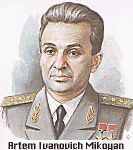 The MiG-21 is the most built jet ever. Fast, small, agile dependable (performance data), and above all simple, it could be turned out in prodigious numbers, and was. It flooded the skies above Europe, Asia, Africa, and even Central America with literally thousands of modern, deadly fighters. It has flown in more wars than any other airplane in the world. An estimated 10,000 (some sources state as much as 13,000 copies) of them have been produced by the Soviet Union, it's allies and (without license) China. The MiG-21 is outnumbered only by WWII airplanes and in modern days only by one, the Lockheed C-130 Hercules. First introduced in service with the Soviet Air Force in 1959, it continued front line service for more than 30 years. A record equal, and parallel, to the McDonnell Douglas F-4 Phantom II. The operational record, now entered its fourth decade, may well extend into the next century with i.e. the Chinese and Eastern Europe Air Forces.
The MiG-21 is the most built jet ever. Fast, small, agile dependable (performance data), and above all simple, it could be turned out in prodigious numbers, and was. It flooded the skies above Europe, Asia, Africa, and even Central America with literally thousands of modern, deadly fighters. It has flown in more wars than any other airplane in the world. An estimated 10,000 (some sources state as much as 13,000 copies) of them have been produced by the Soviet Union, it's allies and (without license) China. The MiG-21 is outnumbered only by WWII airplanes and in modern days only by one, the Lockheed C-130 Hercules. First introduced in service with the Soviet Air Force in 1959, it continued front line service for more than 30 years. A record equal, and parallel, to the McDonnell Douglas F-4 Phantom II. The operational record, now entered its fourth decade, may well extend into the next century with i.e. the Chinese and Eastern Europe Air Forces.
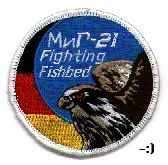 The MiG-21 is not known for its radar or hauling capabilities, nor for its target acquisition equipment or range, but its known that in many ways it was a pilot's plane. It doesn't have any computers or fancy navigation equipment. It very much depends on the pilot and his (hopefully) good training and experience. That, we all know now, was the MiG-21's Achilles verse in many of the wars it had to fight, and is responsible for the not so impressive combat records that it actually deserves.
The MiG-21 is not known for its radar or hauling capabilities, nor for its target acquisition equipment or range, but its known that in many ways it was a pilot's plane. It doesn't have any computers or fancy navigation equipment. It very much depends on the pilot and his (hopefully) good training and experience. That, we all know now, was the MiG-21's Achilles verse in many of the wars it had to fight, and is responsible for the not so impressive combat records that it actually deserves.
A shock to Phantom pilots when it arrived in the skies over Vietnam, was overcome by superior USAF training and a change in rules of engagements.
The MiG-21 proved itself over and over as a formidable dogfighter against the heavier American fighters which was another reason for the success of the MiG-21. Its reliable engine, easy maintenance, rough field capabilities, and save flight characteristic made it the most successful jet aircraft of all times.

The MiG-21 Saga
Acknowledgements: This report is in part based on information provided in "MiG-21 Fishbed in Action" by Squadron/Signal pub.Inc., as well as "Russia's Top Guns" by Gallery Books
In 1956 the USSR put on an air display in which many new prototypes were revealed. From a few blurred pictures Western analysts tried to evaluated these aircraft. They could hardly have made a bigger mess of it and nearly six years later, when India startled the world the world by announcing that it was buying the MiG-21, the general view was that it was rejected by its own country, which was thought to be using the swept-wing MiG design called "Faceplate" by NATO.
 The first prototype, designated Ye-2 with swept wings, flew for the first time on 14 February 1955. The second version of preproduction prototypes was the Ye-50, powered by the AM-9Ye jet engine and a Dutchkin S-155 liquid fueled rocket engine, first flight on 9 January 1956. Ye-50/2 reach an Altitude of 25600 m (83989.5 ft) and a speed of 1460 km/h (907.2 mph).
The first prototype, designated Ye-2 with swept wings, flew for the first time on 14 February 1955. The second version of preproduction prototypes was the Ye-50, powered by the AM-9Ye jet engine and a Dutchkin S-155 liquid fueled rocket engine, first flight on 9 January 1956. Ye-50/2 reach an Altitude of 25600 m (83989.5 ft) and a speed of 1460 km/h (907.2 mph).
Soon, it became clear that the swept wing design would not offer the performance needed to reach Mach 2 under operational conditions (speed w/o the rocket engine were considerable slower). The Ye-4 was basically Ye-2 with a delta wing. The following Ye-5 had the new AM-11 engine and was nearly 700 km/h (434 mph) faster than its predecessor.
Three preproduction aircraft were built under the designation Ye-6 with an approved, more reliable AM-11, designated the R-11F-300. Bigger flaps, a redesigned nozzle, ventral fin and horizontal tail were other changes. A speed of M 2.05 at 12050 m (40000 ft) was reached.
During 1959 and into 1960 a small batch of MiG-21's were built (company designation Ye-6T, known as MiG-21F and Soviet Air Force designation Type 72, NATO Fishbed B). It was equipped with a gun sight, a radar range finder and was armed with two 30 mm cannons with 60 rounds per gun.
The First Generation
The first type built in substantial numbers was the MiG-21F-13 (Soviet AF Type 74, NATO Fishbed C).  It had an enlarged ventral fin, a different canopy, only one cannon, two hard points under the wing, a KAP-2 autopilot, radio compass, radio altimeter, multi-channel radio, radio beacon receiver, IFF and radar warning receiver. It could accept one 490 liter (129 gal) drop tank, two R-13 (NATO AA-2 Atoll) IR AAM's or two rocket pods of up to 16 57mm unguided AGM each.
Starting in 1962 the first MiG-21F-13 (see performance data) were exported to Warsaw Pact countries. Production of MiG-21U trainers started in 1962. Due to the obvious shortage on trainers at that time, several air forces including the East German Air Force had to train the first MiG-21 pilots without a two-seat version.
It had an enlarged ventral fin, a different canopy, only one cannon, two hard points under the wing, a KAP-2 autopilot, radio compass, radio altimeter, multi-channel radio, radio beacon receiver, IFF and radar warning receiver. It could accept one 490 liter (129 gal) drop tank, two R-13 (NATO AA-2 Atoll) IR AAM's or two rocket pods of up to 16 57mm unguided AGM each.
Starting in 1962 the first MiG-21F-13 (see performance data) were exported to Warsaw Pact countries. Production of MiG-21U trainers started in 1962. Due to the obvious shortage on trainers at that time, several air forces including the East German Air Force had to train the first MiG-21 pilots without a two-seat version.
The MiG-21F-12 was a special export designation for Fishbed C's that were delivered to Finland. On 6 April 1963, the first 10 MiG-21F-12's arrived in Finland, a non Warsaw Pact country.
Czechoslovakia started producing MiG-21F-13 in 1962 for use in their own air force. A small number was also exported to East Germany.
China was another country to receive their first MiG-21's in 1962. Their own production of F-13 (called F-7's for export and J-7s in China) started in 1966. Exports went to Albania, Tanzania, Zimbabwe, Iran, Iraq, Pakistan, Bangladesh and Sri Lanka.
The Second Generation
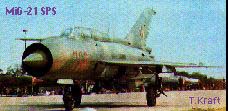
The next generation of MiG-21 featured a number of modifications intended to extend its endurance and give the fighter a better all weather capability. It was done through enlarging. The nose section was completely redesigned. A larger nose cone was able to house the first generation of MiG-21 radar. The ventral fin was enlarged again to hold more fuel. The landing gear was modified to deal with the higher gross weight which required bigger wheel and bulges in the fairings. The speed brakes were modified, too. From just two in tandem under the fuselage, they replaced the forward one by two speed brakes which were higher on the fuselage sides and retaining the rear belly speed brake. (MiG-21PFM Walkaround)The carriage of a belly drop tank disabled the belly speed brake (or brakes in case of the F-13 then had no air brakes when carrying a drop tank) The boom pitot tube was moved from the bottom to the top of the nose, and the vanes for the angle correction of the gyro gun sight disappeared, because it didn't need them any more. 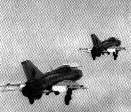 The MiG-21P/PF/PFM/SPS's were without a cannon. Soviet doctrine agreed with that of the US that improvements in AAM's made internal cannons unnecessary. Combat experience in Vietnam later proved how wrong this doctrine was.
The first production variant was the MiG-21PF (NATO Fishbed D). It had a slightly more powerful engine, the R-11F2-300 with 13118 lbs of thrust. Armament was the same as for the F-13 except for the cannon. The PF could deploy R-13R (AA-2 Atoll) radar guided AAM's. The later models had an approved radar, the RP-21.
The MiG-21PFV was a special version exclusively produced for North Vietnam and were specially prepared for the humid and hot climate of SE Asia. It had the less sophisticated R-2L radar.
The MiG-21FL was a special variant for India. It had the same radar as the PFV and the R-11F-300 engine. Licensed production began in 1966.
The MiG-21PFM (NATO Fishbed F) or sometimes called MiG-21SPS (East German Air Force) had a new canopy arrangement (side-hinged), a new ejection seat, the KM-1, and blown flaps. Bleed air from the compressor section was ejected over the upper flap surface. It was possible to fit a gun pod on the fuselage centerline. These aircraft were referred to as PFM-K's or SPS-K's.
The MiG-21P/PF/PFM/SPS's were without a cannon. Soviet doctrine agreed with that of the US that improvements in AAM's made internal cannons unnecessary. Combat experience in Vietnam later proved how wrong this doctrine was.
The first production variant was the MiG-21PF (NATO Fishbed D). It had a slightly more powerful engine, the R-11F2-300 with 13118 lbs of thrust. Armament was the same as for the F-13 except for the cannon. The PF could deploy R-13R (AA-2 Atoll) radar guided AAM's. The later models had an approved radar, the RP-21.
The MiG-21PFV was a special version exclusively produced for North Vietnam and were specially prepared for the humid and hot climate of SE Asia. It had the less sophisticated R-2L radar.
The MiG-21FL was a special variant for India. It had the same radar as the PFV and the R-11F-300 engine. Licensed production began in 1966.
The MiG-21PFM (NATO Fishbed F) or sometimes called MiG-21SPS (East German Air Force) had a new canopy arrangement (side-hinged), a new ejection seat, the KM-1, and blown flaps. Bleed air from the compressor section was ejected over the upper flap surface. It was possible to fit a gun pod on the fuselage centerline. These aircraft were referred to as PFM-K's or SPS-K's.
The Third Generation
Besides the MiG-21R/S/and SM, the more famous third generation MiG-21's are the M's and MF's. The MiG-21M was the export version of the SM and had the older R-11F2S-300 engine and still the RP-21 radar as opposed to the more sophisticated Soviet SM variant. The MiG-21M (NATO Fishbed H) probably was the most unliked version (by pilots) of the MiG-21. It now could carry 2650 liters (700 gal) of internal fuel as well as three 490 liter drop tanks, or one 800 liter (211 gal), and two AAM's (four AAM's with the 800 liter drop tank) on four under wing hard points. It also had an internal GSch-23 twin-barrel cannon with 250 rounds. It now was a considerably heavier aircraft with serious performance shortages. That lead to the development of the MiG-21MF with an uprated R-13-300 engine with 14550 lbs of thrust(performance data).  Soviet MF's also had a the more advanced RP-22 radar.
Improvements to the M and MF's included the new AP-155 Autopilot, a truly 3-axis autopilot with altitude hold, unusual attitude recovery, and automatic terrain clearance hold.
MiG-21MF's saw considerably combat in Afghanistan and the Iran-Iraq war (one kill against an IRIAF F-14 Tomcat).
MiG-21M's were also built in India under license and China (MF) without license. This aircraft features western avionics and have the option of carrying the French Matra Magic AAM in addition to the normal Chinese AIM-9 Sidewinder copies.
Another third generation MiG-21 was the SMT (NATO Fishbed K), flown only by Soviet Air Force pilots. Production was short lived (between 1971 and 1972)The enlarged dorsal spine (to carry more fuel, 3250 liter internal) had adverse effects on the aircraft's flight characteristics.
Soviet MF's also had a the more advanced RP-22 radar.
Improvements to the M and MF's included the new AP-155 Autopilot, a truly 3-axis autopilot with altitude hold, unusual attitude recovery, and automatic terrain clearance hold.
MiG-21MF's saw considerably combat in Afghanistan and the Iran-Iraq war (one kill against an IRIAF F-14 Tomcat).
MiG-21M's were also built in India under license and China (MF) without license. This aircraft features western avionics and have the option of carrying the French Matra Magic AAM in addition to the normal Chinese AIM-9 Sidewinder copies.
Another third generation MiG-21 was the SMT (NATO Fishbed K), flown only by Soviet Air Force pilots. Production was short lived (between 1971 and 1972)The enlarged dorsal spine (to carry more fuel, 3250 liter internal) had adverse effects on the aircraft's flight characteristics.
The Fourth Generation
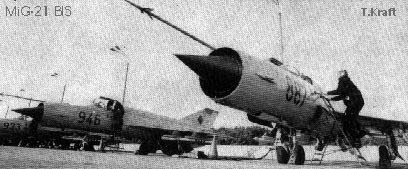
The combat record of the MiG-21 in various areas that the aircraft had been committed to combat - from Vietnam to India to the Middle East - were carefully studied with the aim of making further improvements. Changes were needed to give the Fishbed an improved capability for low level combat and increased endurance while carrying a good weapon load.
Internally the new redisign of the MiG-21 was so complete that it was closer to a new design. Externally however, it was very similar to the MF.
Some of the changes: A new engine (R-25 with 16535 lbs of thrust performance data), most avionics were adopted from the MiG-23 including RSBN (comperable to TACAN), coupled approach capabilities, introduction of the RP-22 monopuls radar to the export variant.
Two different versions of the bis are known, the regular bis (PPL Type 75, NATO Fishbed L) and the SAU-bis (Type 75A, Fishbed N). Both modifications were flown by the East German Air Force.
The Fifth Generation ???
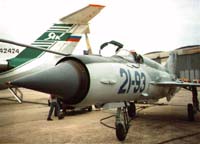
Well, this is a chapter in MiG-21 history still to be written. However, there are several attempts by companies in at least 4 countries to keep the MiG's flying.
Two Indian MiG-21bis aircraft are shortly (September '95) to return to Russia for an
avionics upgrade as part of a general modernisation programme, according to the Russian PostFactum news agency. "Indian Air
Force Commander-in-Chief Marshal Kaul told journalists in Goa on Sunday 27th August that the modernisation project would
extend  the term of operation of the MiG-21bis by another 15 years," the agency said. Kaul said that only two aircraft would be
returned to Russia for the upgrade. The remaining 128 MiG-21bis aircraft in service in India will be modernised at Hindustan
Aeronautics Ltd (HAL) in Bangalore, by Indian technicians trained in Russia. The aircraft will be retrofitted with both Russian
and Western radar and avionics, the agency said.
the term of operation of the MiG-21bis by another 15 years," the agency said. Kaul said that only two aircraft would be
returned to Russia for the upgrade. The remaining 128 MiG-21bis aircraft in service in India will be modernised at Hindustan
Aeronautics Ltd (HAL) in Bangalore, by Indian technicians trained in Russia. The aircraft will be retrofitted with both Russian
and Western radar and avionics, the agency said.
Is that the upgrade now known as MiG-21-93? We'll see! Here are two cockpit images of the MiG-21-93 supplied by Eyk Heinemann of Berlin which he made at the ILA '96. Click on the thumbnails to see the big picture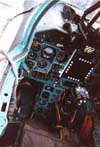
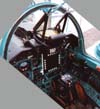
Israel is another country fighting for upgrade money. According to Air Forces Monthly, the first Example of a Westernised Fishbed, the IAI MiG-21 2000, flew on May 24 1995.
IAI is currently upgrating Cambodian and Zambian Air Force MiG-21s. At a unit cost of between $1.5 and 3 million, the avionics
suite options include an Eltra fire-control radar and communication set, an El-Op head-up-display (HUD), and Astronautics
computers and displays.
Weapons options include the Rafael Python 3 air-to-air missile, and the MBT Griffin laser-guided bomb which is also reported to
be included in the Romanian upgrade program managed by Elbit Systems Ltd. , the first prototype of which was expected to fly late in 1995.
Also see Israel Military Industries Ltd. for more information on this subject.
Disclaimer: The information on "The MiG-21 Page" is without any guarantee on part of the author, who also disclaims any liability incurred in connection with the use of this data or specific details.









Transfer interrupted!

The MiG-21 is the most built jet ever. Fast, small, agile dependable (performance data), and above all simple, it could be turned out in prodigious numbers, and was. It flooded the skies above Europe, Asia, Africa, and even Central America with literally thousands of modern, deadly fighters. It has flown in more wars than any other airplane in the world. An estimated 10,000 (some sources state as much as 13,000 copies) of them have been produced by the Soviet Union, it's allies and (without license) China. The MiG-21 is outnumbered only by WWII airplanes and in modern days only by one, the Lockheed C-130 Hercules. First introduced in service with the Soviet Air Force in 1959, it continued front line service for more than 30 years. A record equal, and parallel, to the McDonnell Douglas F-4 Phantom II. The operational record, now entered its fourth decade, may well extend into the next century with i.e. the Chinese and Eastern Europe Air Forces.
The MiG-21 is not known for its radar or hauling capabilities, nor for its target acquisition equipment or range, but its known that in many ways it was a pilot's plane. It doesn't have any computers or fancy navigation equipment. It very much depends on the pilot and his (hopefully) good training and experience. That, we all know now, was the MiG-21's Achilles verse in many of the wars it had to fight, and is responsible for the not so impressive combat records that it actually deserves.

The first prototype, designated Ye-2 with swept wings, flew for the first time on 14 February 1955. The second version of preproduction prototypes was the Ye-50, powered by the AM-9Ye jet engine and a Dutchkin S-155 liquid fueled rocket engine, first flight on 9 January 1956. Ye-50/2 reach an Altitude of 25600 m (83989.5 ft) and a speed of 1460 km/h (907.2 mph).
It had an enlarged ventral fin, a different canopy, only one cannon, two hard points under the wing, a KAP-2 autopilot, radio compass, radio altimeter, multi-channel radio, radio beacon receiver, IFF and radar warning receiver. It could accept one 490 liter (129 gal) drop tank, two R-13 (NATO AA-2 Atoll) IR AAM's or two rocket pods of up to 16 57mm unguided AGM each. Starting in 1962 the first MiG-21F-13 (see performance data) were exported to Warsaw Pact countries. Production of MiG-21U trainers started in 1962. Due to the obvious shortage on trainers at that time, several air forces including the East German Air Force had to train the first MiG-21 pilots without a two-seat version.
The MiG-21P/PF/PFM/SPS's were without a cannon. Soviet doctrine agreed with that of the US that improvements in AAM's made internal cannons unnecessary. Combat experience in Vietnam later proved how wrong this doctrine was. The first production variant was the MiG-21PF (NATO Fishbed D). It had a slightly more powerful engine, the R-11F2-300 with 13118 lbs of thrust. Armament was the same as for the F-13 except for the cannon. The PF could deploy R-13R (AA-2 Atoll) radar guided AAM's. The later models had an approved radar, the RP-21. The MiG-21PFV was a special version exclusively produced for North Vietnam and were specially prepared for the humid and hot climate of SE Asia. It had the less sophisticated R-2L radar. The MiG-21FL was a special variant for India. It had the same radar as the PFV and the R-11F-300 engine. Licensed production began in 1966. The MiG-21PFM (NATO Fishbed F) or sometimes called MiG-21SPS (East German Air Force) had a new canopy arrangement (side-hinged), a new ejection seat, the KM-1, and blown flaps. Bleed air from the compressor section was ejected over the upper flap surface. It was possible to fit a gun pod on the fuselage centerline. These aircraft were referred to as PFM-K's or SPS-K's.
Soviet MF's also had a the more advanced RP-22 radar. Improvements to the M and MF's included the new AP-155 Autopilot, a truly 3-axis autopilot with altitude hold, unusual attitude recovery, and automatic terrain clearance hold. MiG-21MF's saw considerably combat in Afghanistan and the Iran-Iraq war (one kill against an IRIAF F-14 Tomcat). MiG-21M's were also built in India under license and China (MF) without license. This aircraft features western avionics and have the option of carrying the French Matra Magic AAM in addition to the normal Chinese AIM-9 Sidewinder copies. Another third generation MiG-21 was the SMT (NATO Fishbed K), flown only by Soviet Air Force pilots. Production was short lived (between 1971 and 1972)The enlarged dorsal spine (to carry more fuel, 3250 liter internal) had adverse effects on the aircraft's flight characteristics.
the term of operation of the MiG-21bis by another 15 years," the agency said. Kaul said that only two aircraft would be returned to Russia for the upgrade. The remaining 128 MiG-21bis aircraft in service in India will be modernised at Hindustan Aeronautics Ltd (HAL) in Bangalore, by Indian technicians trained in Russia. The aircraft will be retrofitted with both Russian and Western radar and avionics, the agency said.

